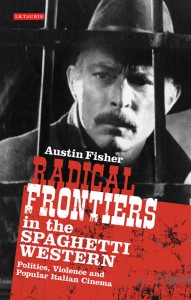Radical Frontiers in the Spaghetti Western
Radical Frontiers in the Spaghetti Western by Austin Fisher (IB Tauris, reprint edition, 2014), 320 pages, ISBN: 978-1780767116 (paperback), £17.99
About the Reviewer: Dr Lee Broughton is a Leverhulme Trust Early Career Fellow at the University of Leeds where he teaches Film Studies. He has written extensively on both national and international European Westerns, contributing to publications such as The Directory of World Cinema: Germany volume 2 (2013), International Westerns: Re-Locating the Frontier (2014) and Impure Cinema: Intermedial and Intercultural Approaches to Film (2014). His current research is concerned with investigating the representations of ‘North’ and ‘South’ found in Italian Westerns.
The Italian-made Spaghetti Westerns of the 1960s and 1970s are currently being appreciated by a new generation of cult film fans thanks to a number of timely DVD releases. But while much has been written about Sergio Leone’s films, the work of many of the genre’s other directors continues to be ignored by both film historians and the academy.
Austin Fisher’s Radical Frontiers addresses this situation by focusing on the political Westerns produced by five noted Italian directors: Damiano Damiani, Sergio Sollima, Sergio Corbucci, Giulio Questi and Giulio Petroni. Fisher asserts that these directors drew upon elements of American and Italian culture in order to produce politically charged hybrid Westerns. Furthermore, Fisher argues that these Westerns invariably featured ideological content that chimed with the outlooks of a number of radical groups that were operating inside Italy at the time of their release.
Barry Langford’s cover testimonial, which praises the book’s ‘deft interweaving of political theory, political history and critical analysis’, succinctly describes Fisher’s approach here. History dominates chapters one and two, wherein Fisher provides a context for his argument by presenting a comprehensive account of the social and political problems that arose in Italy after the country’s unification in 1861. He also discusses the key aspects of the Western genre – and American history and culture in general – that reportedly appealed to post-World War II Italians before detailing the circumstances that led to the emergence of Italy’s student activists, politicised workers and violent terrorists during the late 1960s and early 1970s.
In chapters three and four, Fisher cogently draws upon the political theories of Fanon, Althusser, Marcuse and Benjamin in order to discuss his chosen films’ ideological constructions of American and Mexican history and their representations of society and ethnic insurgency. As such, these chapters could be usefully employed on film studies modules that possess a strong cultural studies bias. Equally, Fisher’s critical analyses of key sequences from the films could be used to offer students good examples of how film studies terminology should be deployed when critically breaking down and interpreting short scenes.
Fisher’s sharp analytical work here identifies two distinct types of political Italian Westerns and he duly constructs two models that support his argument: the ‘Repressive State Apparatus’ model (which highlighted the inherent violence and latent fascism found at the core of society) and the ‘insurgency’ model (which encouraged violent and radical opposition to American imperialism). The political intentions that are assigned to both variants remain plausible when placed within the rich contextual history of Italy that the book presents. However, Fisher’s subsequent analysis of the way that the films encourage the spectator to identify with particular characters suggests that the intended political messages were not always successfully delivered.
Chapter five considers how the Italian films fared in America while also providing a series of interesting contrasts between their content and that of later American productions. Initially, New Hollywood’s revisionist Westerns are the major point of focus here. While Fisher concludes that American audiences tended not to recognize the Italian Westerns’ political aspects, he does suggest that the films did have a stylistic and narrative influence on American filmmakers. For example, pertinent links are drawn between the Italian films and Blaxploitation movies but this relatively short exercise feels slightly underdeveloped since Fisher focuses predominantly on just two black film directors, Melvin and Mario Van Peebles. Student interest might be stimulated by the connections that Fisher subsequently draws between the Italian films and those of Robert Rodriguez and Quentin Tarantino.
The book’s short final chapter endeavours to place the selected Italian Westerns within contemporary Europe’s wider spectrum of political filmmaking. Here the Italian directors’ routine employment of the ‘classical’ Hollywood style is contrasted with the Brechtian approach associated with Jean-Luc Godard’s work, particularly his Western Vent d’Est (1970). This quite fascinating exercise works well enough but consideration of the methods employed by other European directors who made idiosyncratic political Westerns (Marco Ferreri, Rainer Werner Fassbinder) might have granted Fisher a broader critical canvas to work with for his finale.
Academically thorough but extremely accessible, Radical Frontiers offers an engrossing and welcome insight into the work of a handful of overlooked Italian directors and the contemporary politics that guided their craft.
Dr Lee Broughton
 Learning on Screen
Learning on Screen